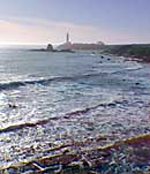Punta de las Ballenas
 In the early 1800s Pigeon Point was known as Punta de las Ballenas (Whale Point) because gray whales passed nearby during their migrations between the Arctic and Baja California. Few ships ever passed the Point until gold was discovered in the Sierra foothills in 1848. Then the ocean off Whale Point became a veritable marine highway. Vessels of all types were pressed into service to carry gold-seekers and goods to the booming town of San Francisco. But the fog, gales, currents and reefs made the area a graveyard for many vessels. One victim was the clipper ship Carrier Pigeon. While lost in fog on the last leg of her maiden voyage from Boston to San Francisco, she ran aground at Whale Point on June 6, 1853. The Carrier Pigeon broke apart and sank on a ledge of rocks just 500 feet from shore. In her memory, Whale Point became Pigeon Point.
In the early 1800s Pigeon Point was known as Punta de las Ballenas (Whale Point) because gray whales passed nearby during their migrations between the Arctic and Baja California. Few ships ever passed the Point until gold was discovered in the Sierra foothills in 1848. Then the ocean off Whale Point became a veritable marine highway. Vessels of all types were pressed into service to carry gold-seekers and goods to the booming town of San Francisco. But the fog, gales, currents and reefs made the area a graveyard for many vessels. One victim was the clipper ship Carrier Pigeon. While lost in fog on the last leg of her maiden voyage from Boston to San Francisco, she ran aground at Whale Point on June 6, 1853. The Carrier Pigeon broke apart and sank on a ledge of rocks just 500 feet from shore. In her memory, Whale Point became Pigeon Point.
A shore whaling station operated here as well. The whalers, settlers from the Portuguese islands of the Azores, would post a look-out to watch for the spouts of passing whales. When a spout was spotted, the cry of "Whale!" was issued. The whalers piled into small boats and rowed furiously out to harpoon the whale. The carcasses were towed back to shore and the blubber was rendered into oil.
